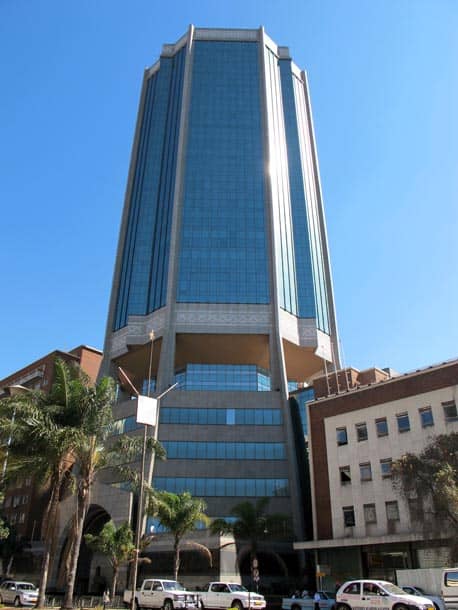The Reserve Bank of Zimbabwe (RBZ) has summoned chief executives of key financial institutions, specifically banks, for a meeting tomorrow morning ahead of the much-anticipated launch of a new currency amid the battered Zimbabwean dollar volatility and surging inflation.
As The NewsHawks has exclusively reported in detail, the new currency will be introduced tomorrow in a bid to stem currency volatility and runaway exchange rate-driven inflation in an economy rapidly deteriorating in the aftermath of last year’s disputed elections.
Repeated stolen Zimbabwean elections always leave the economy further spiralling into renewed turmoil.
Bank chief executives will meet outgoing RBZ governor John Mangudya and his incoming successor John Mushayavanhu to discuss the process and modalities of introducing the structured currency tomorrow through a delayed monetary policy statement.
Zimbabwe has a labyrinth of local currencies operating in a complex chaotic system, together with foreign multi-currencies, an indication of economic chaos and failure.
Mushayavanhu, whose official appointment was brought forward to 28 March instead of 1 May to take ownership of the process and ensure smooth transition, will play a prominent role tomorrow assisted by the outgoing governor.
Mangudya’s term officially ends on 30 April, although he will soon take leave and quietly disappear from the scene before re-emerging later as chief executive of the Mutapa Investment Fund (Sovereign Wealth Fund).
A monetary authority told The NewsHawks:
“We have summoned banks chief executives or heads of key financial institutions to a meeting tomorrow morning to discuss the launch of the new currency before its subsequent announcement.
“We want to brief them about the process and modalities, which they were involved in during consultations anyway, before the monetary policy is delivered.
The plan is for it to be presented by Mushayavanhu, supported by Mangudya who will explain issues afterwards.”
The new currency comes as the increasingly worthless Zimbabwean dollar is now on a freefall – hitting US$1: ZW40 000 in the parallel market – while annual inflation is 55.3%.
Officially, the exchange rate is US$1: ZW22 447.5.
Independent economists say inflation is actually 2 257%; the highest in the world.
Authorities say the new currency will be backed by gold and United States dollar cash reserves.
Market watchers say their word on this should be treated with a pinch of salt because of their unreliable previous behaviour.
However, analysts say officials must simultaneously address deep underlying economic and structural issues if they want the new currency to stand a realistic chance of survival.
The current Zimbabwean dollar was reintroduced into the market in 2019 after 10 years of decimation and later demonisation due to the 2008 economic meltdown and hyperinflation, which broke records and entered the annuls of history.
It current local unit has barely survived five years so far as it spirals towards death yet again.
There have been many versions of the Zimbabwean currency,
including the bearer’s cheques, traveller’s cheques, special agro-cheques and bond notes (with some ZW$100 trillion bank notes) in the recent past as government battled currency volatility and inflation in vain.
Writing on X (Twitter), Professor Gift Mugano outlined the most critical issues buffeting the local currency which he says must be addressed:
“1. Excessive printing of money & excess liquidity caused by command agriculture; wrong financing model on roads & key infrastructures;
- A dominant informal sector which is governed by informal rules & has no regard to govt policies – the informal sector has its own governor, mattress bank, minister of finance, etc.
-
devastating drought & subdued commodity prices which have a combined effect of reducing availability of USD liquidity;
-
unresolved confidence crisis caused by loss of capital/ pensions/ savings/ insurance/ investments as a result of incessant currency collapse & currency crisis;
-
lack of policy clarity – our economic problem is centred around structural rigidities which requires structural policies (industrial, trade and agricultural policies). We haven’t seen much activities & media coverage on these policies in the same way we have seen visibility & pronouncements on monetary & fiscal policies. In short, our structural policies are not up to scratch;
-
drought of production – the best way to defend our currency is to institute policy measures and conditions that promote a productive economy (e.g., sound structural policies, working markets, market led economy, sound financial sector, stable political environment powered by rule of law, constitutionalism and strong institutions);
-
Broken politics – we have invested so much energy on disunity & hate speech instead of fostering peace, unity, tolerance and love. We are allergic to national dialogue, social contract, divergent views, etc. Ironically, we expect to see flawless implementation of public policies and attainment of the desired economic goals when we are divided?
Structured currency = bond note, gold coins/gold token/ZiG. Bond note & ZiG were/are local currencies backed by USD & gold, respectively but failed dismally because of the reasons I mentioned above.
“This is why I am convinced that a local currency or structured currency will always fail as long as the factors raised above are not adequately addressed.”
Newshawks













